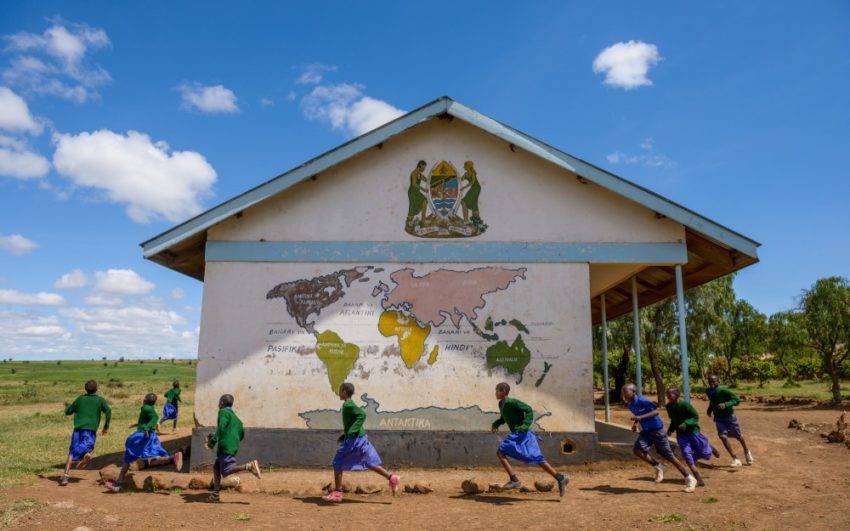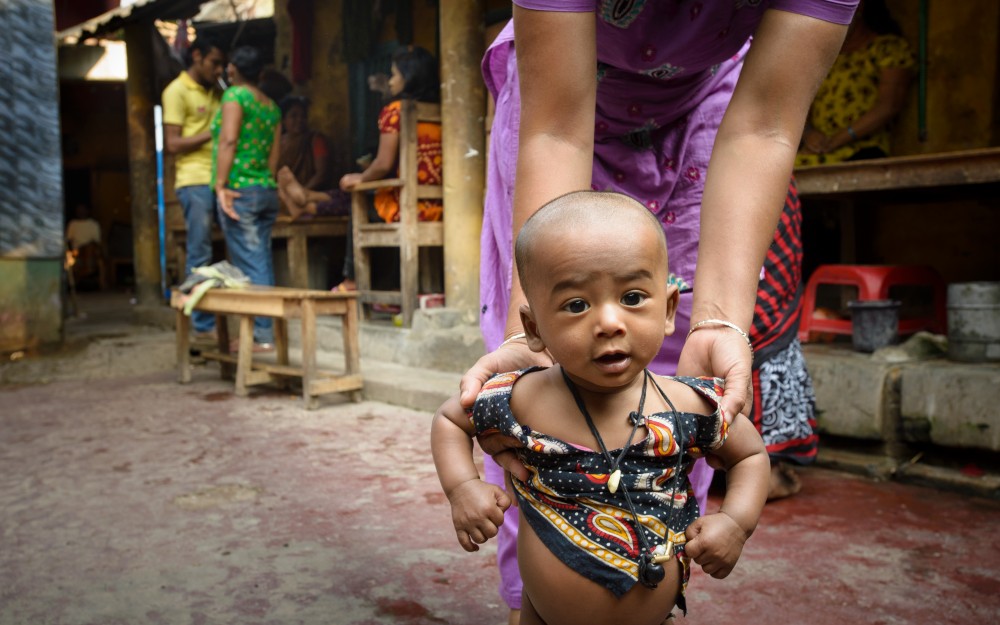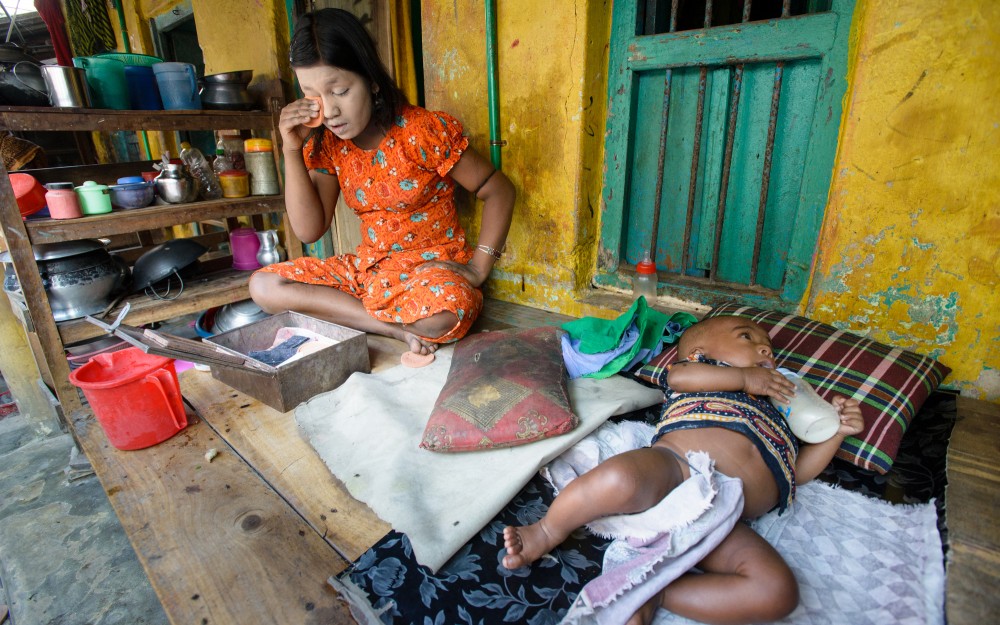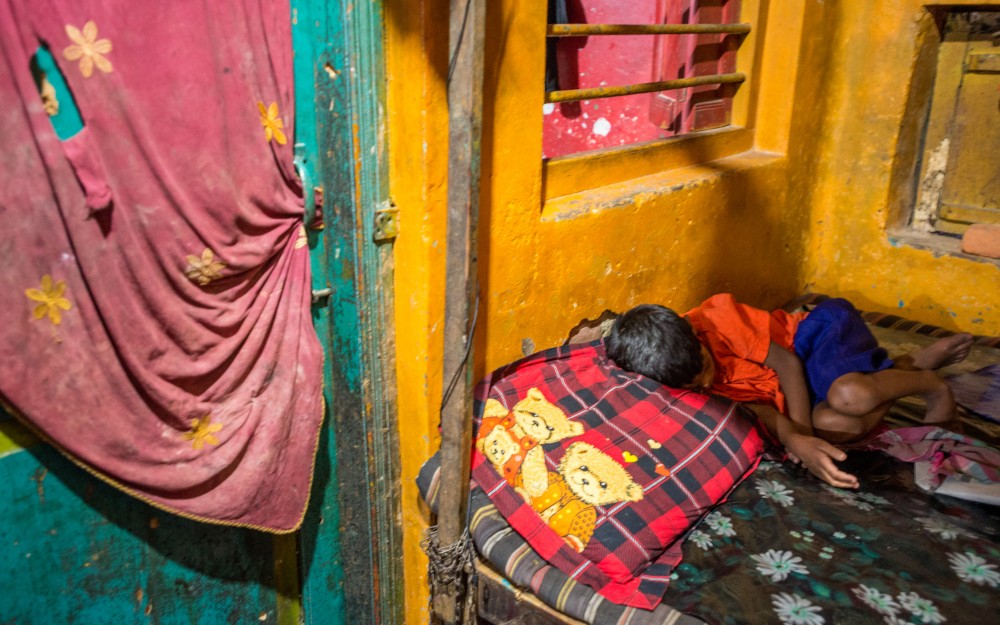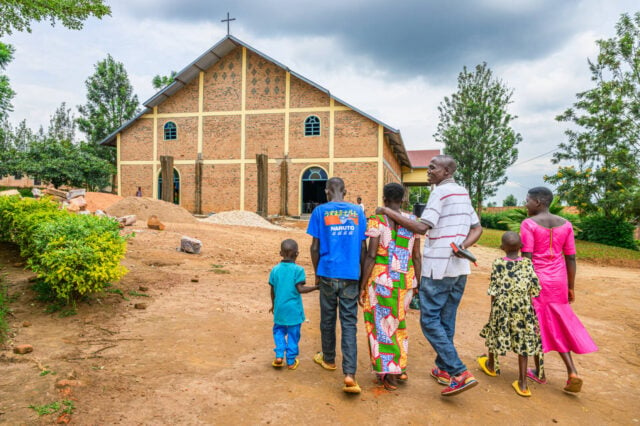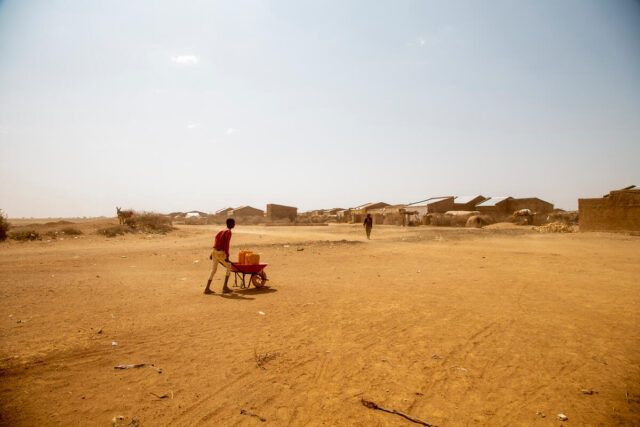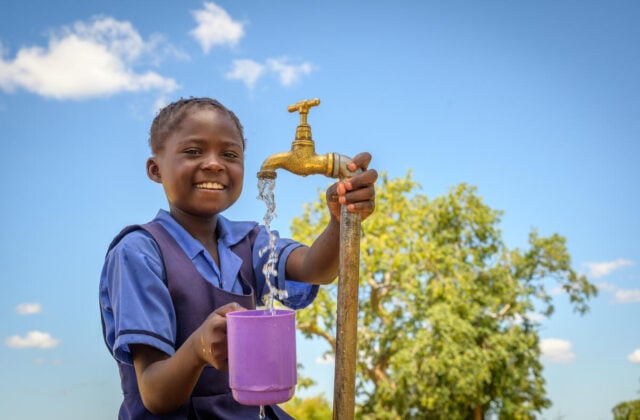World Vision’s award-winning photographers travel around the world every year, capturing moments of God’s grace and faithfulness as we follow Jesus’ example to show unconditional love to the poor and oppressed. They bring back stories that inspire us to action and compassion.
Discover what’s it like behind the scenes during some of these moments.
Birthday in a Bangladesh brothel
Written and photographed by World Vision photographer Jon Warren
* * *
Last year I spent my birthday in a Bangladesh brothel hanging out with prostitutes. And I went there again several weeks ago and was welcomed back as a friend.
Before I get into trouble with my wife, let me explain. World Vision has a Child-Friendly Space — safe havens for the children of sex workers and other at-risk kids in the community — next to quite a few brothels in Bangladesh. Writer Kari Costanza and I were there to report on World Vision’s work.
Soon after we arrived at the Child-Friendly Space — almost immediately, actually — mothers of the kids invited us over to visit their “home,” to see their rooms where the children also spend each night. With some trepidation, I followed Kari and the women down a long corridor, past clients and madams, and into a courtyard surrounded by small rooms. And I had my camera.
What’s it like to be in a horrific place with people who the rest of the world despises and sees as throw-away women?
First of all, they weren’t “prostitutes” to us. They were Moyna, mother of Tumpa, and Jolly, mom to Sojib. Kari chatted and laughed with the ladies, and soon they were doing her nails, fixing up her hair, and pouring out their hearts. (Read more from Kari.)
I struggled with whether to photograph them at all. Ultimately, it was the women’s welcome and their eagerness for us to hear their stories and understand their lives that overcame my reluctance.
So I photographed sparingly and deliberately, carefully choosing moments to raise my camera and concentrating on the women we were with and their children. I wanted to record enough of the setting to give a sense of the awfulness, but not so much that I made the women feel used or as objects. I wanted our readers to learn about the lives of these mothers, to understand the danger to the children, and to care for them.
I used nothing longer than a 50mm lens, nothing big and conspicuous. I only took one or two frames at a time, presetting exposures as often as possible and sitting down for long periods of time in one spot waiting for the right moment. Later we brought back copies of prints to share with the ladies — one for them and the other for their madam.
Kari and I were welcomed because we treated the women respectfully as unique, valuable people. We weren’t clients or voyeurs or even just reporters. We were advocates for their children. And over the course of the assignment, we became their friends.
Mostly though, we were given open access because of World Vision’s staff who are there every day, month after month — staff who not only love the children unconditionally but care for the women, too.
In his time on earth, Jesus was accused of being the friend of all sorts of unsavory people — tax collectors, enemy Roman soldiers, and prostitutes. Where would we find him if he was in Bangladesh today?
Last month Kari and I returned to Bangladesh and followed up with some of these women and children. Next, I’ll share photos from that trip to tell the story of how World Vision’s work has impacted their lives.
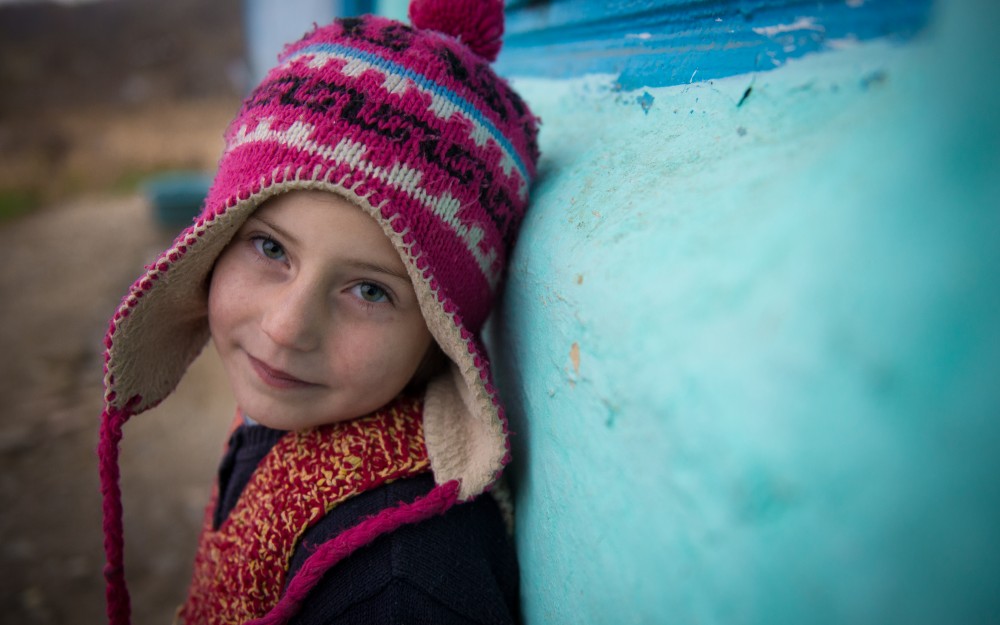
To intervene or not, Romania
Written and photographed by World Vision photographer Laura Reinhardt
Nikon D600
24-70mm lens, 1/80th at f/2.8, 800 ISO
* * *
“What did Santa Claus bring you last year?” asked Magda, a World Vision Romania staff member. Andreea’s joyful smile faded just a bit. “Santa didn’t come last year,” she responded.
Something inside my heart broke for this sweet little girl I’d been photographing for the past half-hour out in the cold Romanian November.
Andreea went to one of the front windows of her house — the chipped blue paint peeling from the wood — opened it, and pulled out something that looked like a one-armed Barbie doll. Magda told me that Andreea really wanted a new doll.
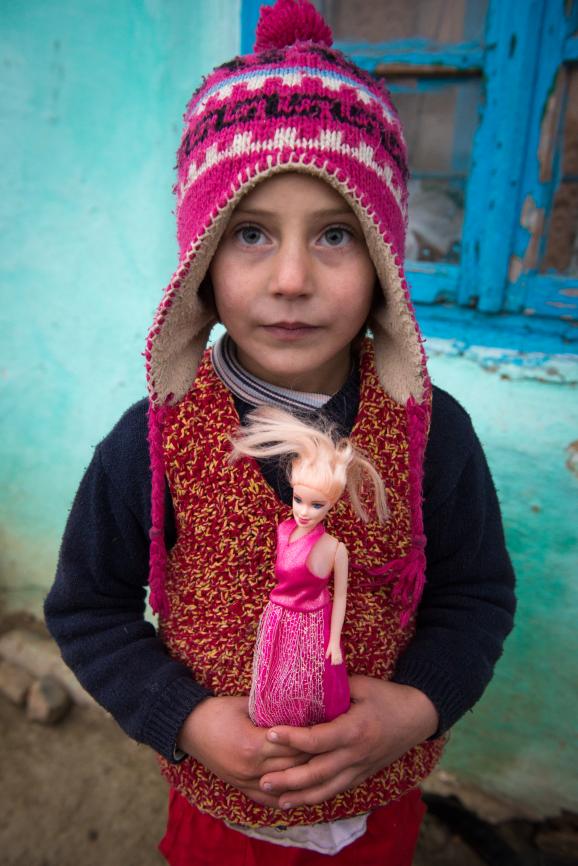
I knew that Andreea and her family had bigger needs — a secure supply of food, house repairs to keep out the cold winter weather, warm clothing, and access to education. But a small gift like a doll was something I could easily provide.
I didn’t want to see Andreea’s joy trampled by the harsh realities of the world. I wanted her to know that someone cared about her; someone heard her very small request.
As a journalist, I’ve learned that I shouldn’t intervene. I document what I see, but should only observe — kind of like Star Trek’s prime directive.
But I also remembered the warning tale I’d heard of Pulitzer Prize-winning photographer Kevin Carter. In 1993, he shot the famous photo of a severely malnourished little girl collapsed on the ground in southern Sudan, while a vulture hovered ominously in the background.
That photo shone a spotlight on the plight of those suffering from famine in Sudan.
Carter received criticism because he didn’t help the girl after taking the picture. “The man adjusting his lens to take just the right frame of her suffering, might just as well be a predator, another vulture on the scene,” declared the St. Petersburg (Florida) Times. The irony was that journalists were advised not to touch the famine victims for fear of spreading disease.
I feel like the photos taken by all of World Vision’s photographers seek to do some similar to what Carter did — shine a light on poverty, elicit emotion, and drive people to act.
But my question still remained: Was it sufficient that my photo would be used to inspire donors and sponsors to support Andreea’s community? Was it also okay for me personally to get involved?
I sought the counsel of the World Vision staff in the community and asked if I could buy a doll for Andreea. They said they didn’t want to encourage dependence in any of the families they served. Their work was all about empowering people like Andreea’s parents so that Santa Claus would come in the future.
But as part of a celebration for the entire community, they assured me that they would make sure Andreea got a doll for Christmas.
This January I got an unexpected email. A World Vision staff member in Romania wrote to pass along a note from Andreea’s older sister.
Thank you for being Santa Claus this year for my little sister, who was very glad because this year Santa Claus didn’t skip her anymore. She was thrilled to have received the doll because she wanted it so much. She played with that doll during the entire holidays. We wish you a lot of health, happiness, and success in the year that has just started.
The image of that sweet-faced little girl with her brand new doll brightened my gray Seattle day.
I believe Andreea would have gotten the doll whether or not I’d asked to buy her one. I certainly didn’t deserve the praise in that letter. World Vision donors and the World Vision staff are the real Santa Clauses and heroes.
Still, I felt glad that in that rural Romanian village, my gut instinct was to help Andreea — not only through my camera but also by getting involved personally.
At a recent National Geographic workshop, the photographer speaking said it’s important to be a human being first and a photographer second. That sums it up best for me.
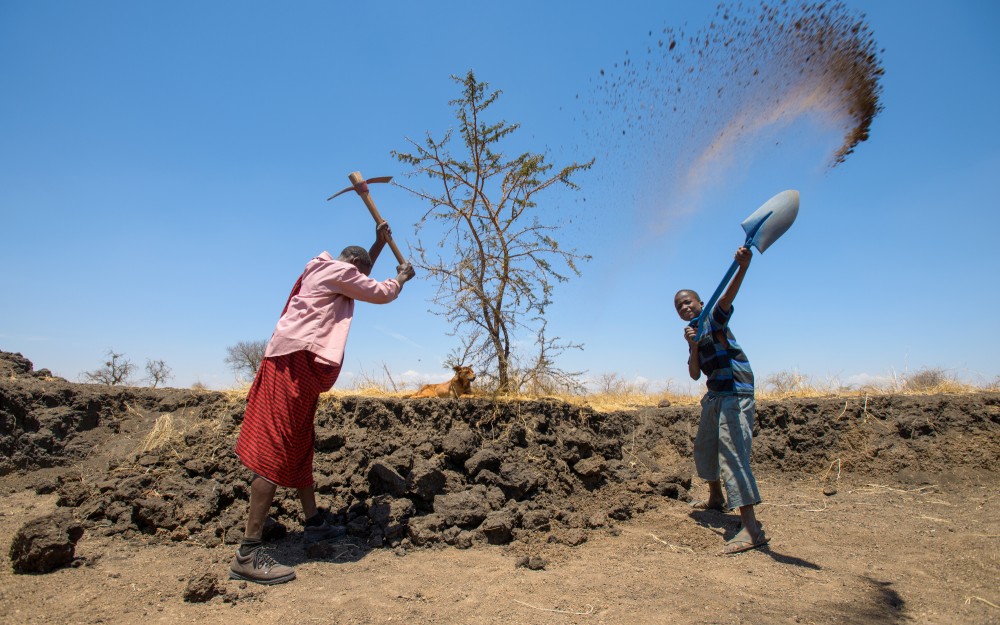
Movies or stills?
Written and photographed by World Vision photographer Jon Warren
Nikon D800
17mm lens, 1/800th at f/5.6, 100 ISO
* * *
Films are fantastic. I watched Jiro Dreams of Sushi the other night. It’s a sensitive documentary about an 80-year-old Japanese sushi chef whose tiny, 10-seat restaurant is considered one of the best in the world. The filmmakers use grand symphony music, insightful and personal interviews, and quietly gorgeous camera work to tell an intimate and touching story of perfection and artistic excellence.
Every time I see a piece like this I’m conscious of the limitations of still photography.
What can we produce with our little cameras that will compare with movies’ combination of motion, sequence, and sound? How can our one frame have an impact on viewers when they have the option of watching a video?
We’re working on final designs for the Autumn issue of World Vision magazine. The opening spread of the main feature story is a photograph of a father and his son digging a water reservoir in Tanzania. An arc of dirt flies off the boy’s shovel, suspended in midair.
The picture freezes one key moment, giving readers a chance to explore that 1/800th of a second in-depth, corner to corner, in a way only a photograph can. There is no time limit on how long the reader spends with the image or how closely they view it. A split second, a single glance can tell a story.
Try that with a movie!
Behind the scenes: If you ever try a photograph like this, be prepared to deal with subjects who can’t understand why the crazy photographer crouches right where they’re aiming their dirt. I came away with pockets filled with rocks and my camera covered in dust. But also big smiles when I showed the family the pictures on my LCD screen after we were all done.
As I worked on the assignment, I asked myself, “Is this specific split second in time worth preserving and sharing?” Movies may have the corner on the sequence, sound, and motion. But we still photographers have time on our side. Savor the moment.
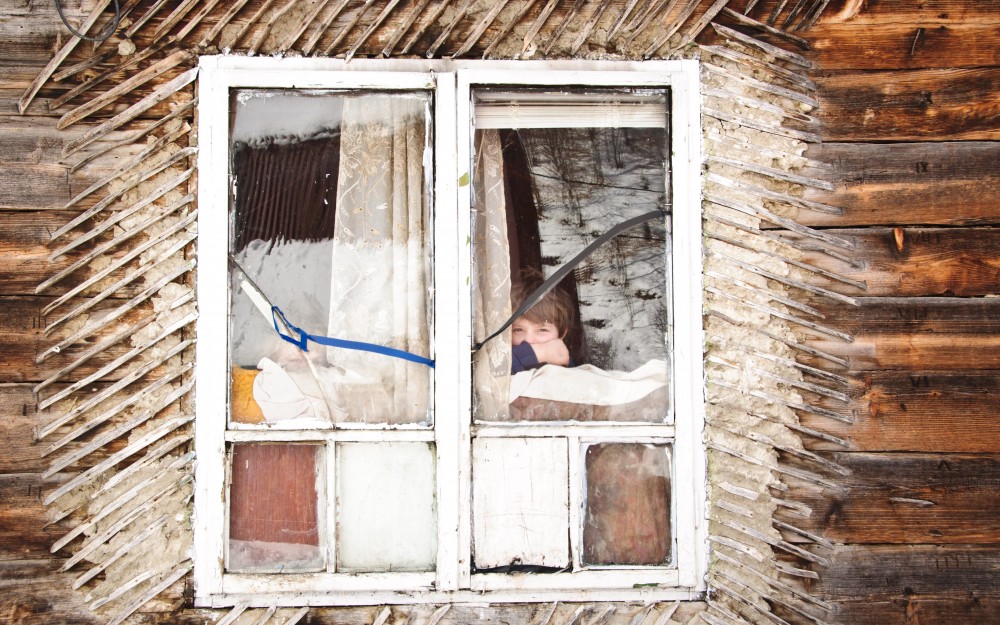
Cracked windows, Romania
Written and photographed by World Vision photographer Laura Reinhardt
Nikon D300
34mm lens, 1/160th at f/10, 320 ISO
* * *
When I go on assignment, I usually have a long list of stories and photos to capture. That catalog of must-haves can often be quite specific. It’s great to have a set of guidelines, but I love capturing moments that wouldn’t be covered on any shot list. Sometimes those are the most compelling and often my personal favorite photos.
On this particular trip, just as I was getting ready to fly out from Seattle, snow began falling in Europe. By the time I arrived in Transylvania, Romania, record snows — the worst in decades — blanketed much of Europe.
The first day’s assignment included a two-hour walk to meet a family. Normally, this would not be a problem. I love walking! I’ve even walked a couple of marathons. But this walk would be up a mountain, and I’d be hiking in snow that came up as high as my knees in some places.
As we stood waiting, the family loaded up the cart behind their horse. They filled it with relief supplies from World Vision to help see them through the worst of the snow. There were warm winter coats, winter boots, and extra rations of food for the coming snowy days.
I looked around at the nearby houses. Two cracked windows drew my attention. Makeshift masking-tape repairs covered those cracks. Wooden panels filled in the broken glass at the windows’ bottom.
I wondered if these remedies prevented the bitter cold from seeping into the home. Exposed wood surrounded the window frame. Had it once been covered and the family couldn’t afford to repair it? Or maybe there never had been money to add those finishing touches.
Then I saw a little face appear in the window. I raised my camera to my eye. He didn’t immediately give me a smile as kids so often do. He didn’t run away, another common response. Instead, his unwavering gaze studied me steadily as my camera focused on him.
I only had time to take a few photos — a couple of the full window and one or two of the boy close up. This particular frame resonated with me because I felt that it told the whole story that I would hear over the coming weeks as I talked to parents in the rural Romanian communities.
Subfreezing temperatures forced parents to keep their children home from school. They feared that the long walks to the local school would leave the children sick, and these parents had no extra money to pay for transportation to a hospital, let alone the medical fees.
For me, this picture speaks to the effects of cold weather on many children and families. The reflected snow tells the reason why they were stuck inside. And the little boy’s expression — wavering between apathy and acceptance — is so different from what I’ve seen and experienced in American kids on snow days.
His wasn’t the story I’d come to Romania to cover. I finished the snowy walk up the mountain, spent time with the family who lived at the top, and brought their story back for our donors to learn about the effectiveness of their contributions. But for me, the boy in the window tells the story of poverty — of what rural children face, especially in inclement weather, and maybe the trapped feeling that people in poverty sometimes experience when they look at the future.
This photo also reminded me that there are stories all around us. As a photographer, I need to be open to seeing those and not so focused on my list of must-haves that I miss those serendipitous moments. Sometimes, even when I do see them, surprises still await.
Case in point, I didn’t even notice the other little boy in the left window until I saw the photo on my computer. I love it when that happens!
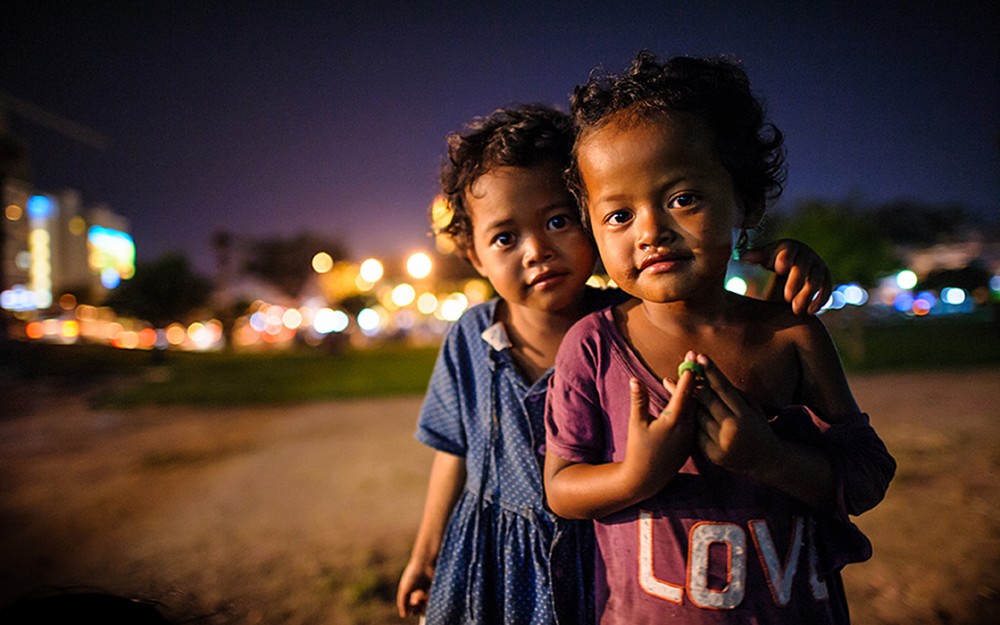
Street children, Cambodia
Written and photographed by World Vision photographer Jon Warren
Nikon D700
24mm lens, 1/40th at f/1.4, 2500 ISO
* * *
Sometimes the glimpse of a story — a brief, unfinished encounter — stays with me the longest. And sometimes placing an important element of a picture in a seemingly subtle spot makes the impact greater.
Along with other guests from the U.S., writer Kari Costanza and I were visiting World Vision’s night ministry to street children in Phnom Penh, Cambodia. We noticed Srechea, 4, right away because her oversized T-shirt said “love” on it. She and her four sisters begged on the street while their mother, Neang Hean, worked at karaoke bars. Kari only had time to ask a few questions. One was, “Where do you sleep?”
Neang Hean and her five daughters took us to a narrow shelf behind a wall on the side of a bridge, and they showed us the precarious spot above a sloping embankment where they tried to find safety and privacy each night. In the distance were the big casinos and bars that dominate this part of town — Neang Hean’s workplace.
The only light on the family’s faces was from a string of bulbs hanging from a construction site on the bridge. I used my D700 because it does so well in low light and an ultrafast 24mm lens, hoping to capture as much of the scene as possible.
When Srechea stopped in front of me, and her sister, Sreay Poeu, 3, came alongside, I quickly clicked a few frames before they moved away. I had already set the lens at its widest opening to gather as much light as possible — f /1.4, and metered for 1/40th of a second at 2500 ISO. I hoped the girls would hold still and that my focus was accurate.
They were beautiful children, and the dark night and bright lights helped tell their story. The “love” in the big white letters on Srechea’s T-shirt was poignant. How much love does she get, this 4-year-old who begs all day while her mother works long hours in a bar? I composed the frame so the letters were in the corner, hoping viewers would first see her direct gaze and only later notice the word.
We didn’t see Srechea again after that night.
We visited another community in Cambodia and heard the dramatic account of how they saved one of their teen girls from trafficking. It was worth telling in detail for World Vision magazine, and that became the focus for Kari and me.
But every time I see this photograph, my heart aches for those five girls and their mother. Have they accepted the help the World Vision staff offered? Or are they still on the street?
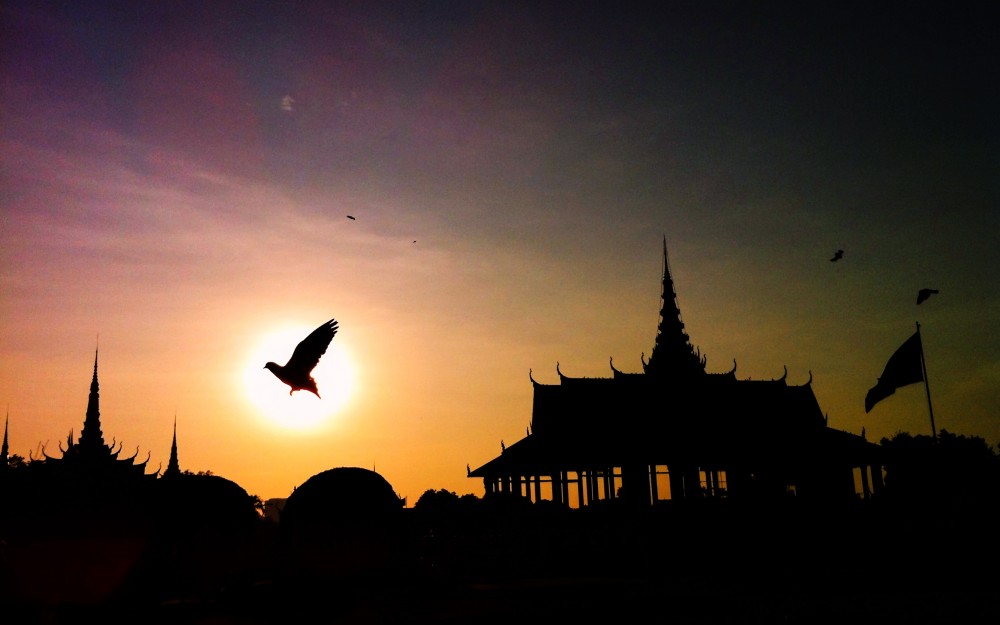
Sun pigeon, Cambodia
Written and photographed by World Vision photographer Jon Warren
iPhone 4, Camera+ app
* * *
Okay, I admit it. I use my iPhone for almost all my personal photography now, especially for static subjects. It’s fun, fuss-free, and I feel much less constrained about tinkering with the pictures afterward. I use the original Camera+ app to emulate HDR or dramatically alter tones. Best 99 cents I’ve ever spent on photography!
Still, the same picture-making principles apply: Look for good light, know what you want to say, put yourself in the best possible situation, and get access.
Standing in front of the spectacular King’s Palace in Phnom Penh, Cambodia, at sunset, I did what every other tourist does these days — grabbed my phone to record the scene. Camera+ let me choose an exposure that rendered the buildings as silhouettes, and the camera made the sun huge. It was an okay picture, but nothing special.
But then I noticed that there were pigeons all over, a big flock taking off every time something disturbed them. And I thought, “How cool would it be if I got a picture of one in the sun?” So each time I saw pigeons take off, I poked the phone screen as fast I could. And after a dozen or so attempts, I was amazed to see a pigeon smack dab in the middle of the sun.
Sometimes good pictures are a matter of happenstance. This is especially true when you use your phone to try to record a peak moment. Actually, any time you’re depending on what the scene or subject provides, there is an element of surprise. Divine intervention, really. A gift.
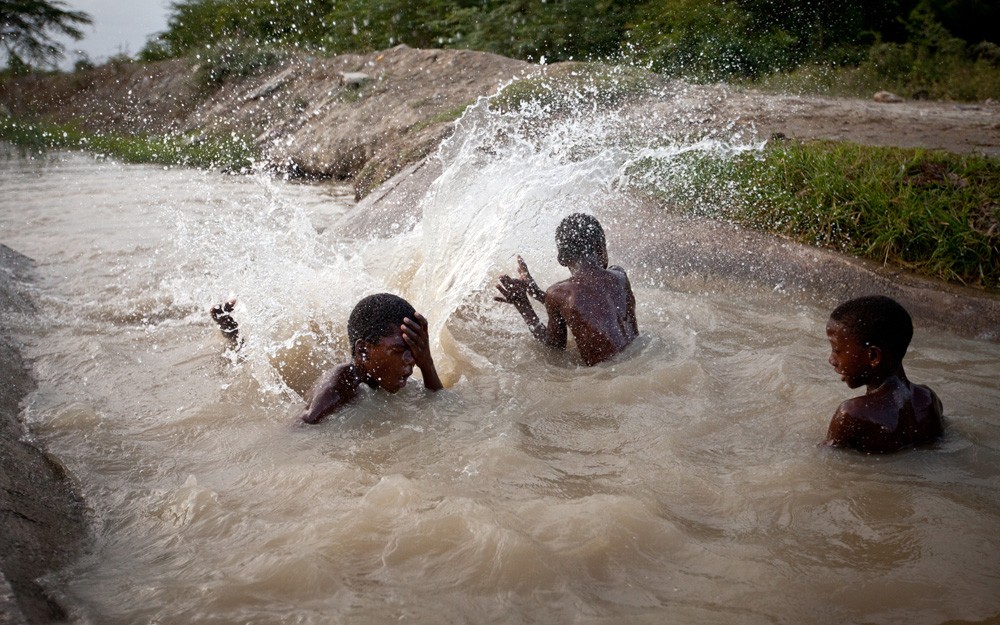
Behind the lens: Waiting
Written and photographed by World Vision photographer Abby Stalsbroten
* * *
Days on assignment in the field can be long, but not always because I’m snapping away on my camera.
We spend many hours driving, in meetings, or waiting for something to happen or someone to show up. So when I get the chance to spend an unhurried half an hour in one spot trying to make a picture, it’s a luxury and a blessing.
I received such a blessing when I was in one of the poorest regions of the Dominican Republic, trying to capture the life of a community surrounded by sugar cane fields and mired in poverty for decades.
Writer Kari Costanza and I came upon these boys as they were taking their daily dip in an irrigation canal at sunset. As soon as they saw my cameras, they began posing, showing off their muscles, and one-upping each other with outrageous dives. A few mooned me. It was hilarious, and I prayed that I had a photo that was at least halfway decent.
Dorothea Lange, famous for her photo known as “Migrant Mother” during the Great Depression, said this about capturing meaningful moments: “You know, so often it’s just sticking around and being there, remaining there, not swooping out in a cloud of dust; sitting down on the ground with people, letting children look at your camera with their dirty, grimy little hands, and putting their fingers on the lens, and you let them, because you know that if you will behave in a generous manner, you’re very apt to receive it, you know?”
And so sometimes — most of the time — you have to get a little grimy, a little dirty. Or, in my case, wet. And then you patiently stay for all their shenanigans and showing off for the camera, until you find a moment when they are lost in play, taking their daily dip at sunset.
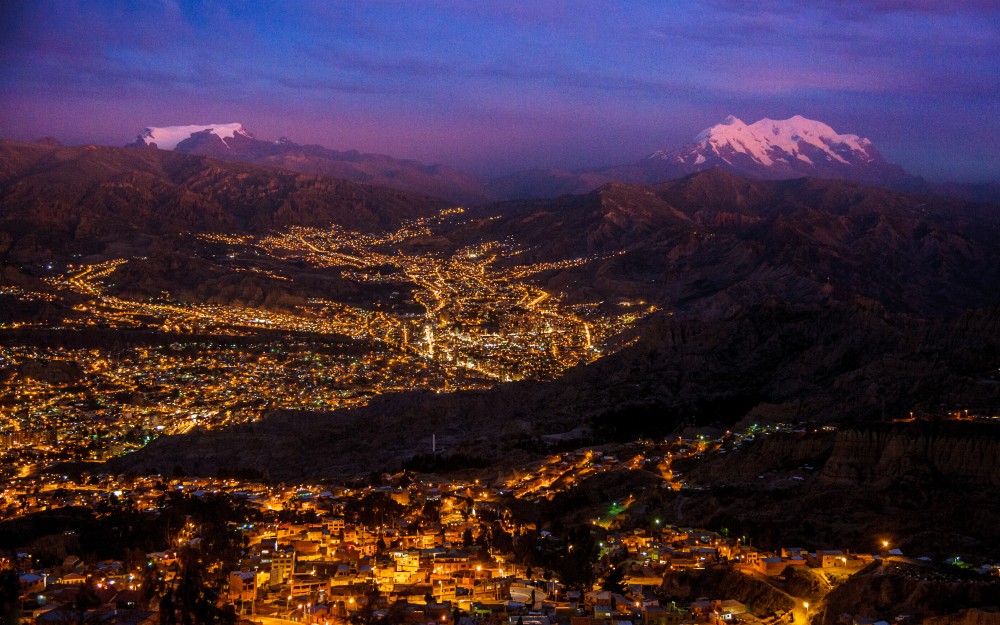
‘f/8 and be there,’ Bolivia
Written and photographed by World Vision photographer Jon Warren
Nikon D3
52mm lens, 1/4th at f/4.5, 1600 ISO
* * *
Photographers are like fishermen. The more we talk about how we got the big one, the more amazing the story gets. We like to recount the enormous challenges we faced, the perseverance required, the incredible insight we had into how to get the fish to bite. And we never, ever, reveal the special lure we used. Then we hang the trophy on the wall.
But there’s an old photography adage that is closer to reality: “f/8 and be there.”
It comes from the days when you had to manually set the aperture on your camera. By using a lens opening of f/8, an average setting, you were likely to have most of the scene in focus and reasonable exposure. All that was required was for the photographer to show up.
A friend found a photo of mine that she liked from Bolivia — an evening scene of the city of La Paz. She asked how it was possible to get the photo and wondered if I’d taken it from the air.
I wanted to tell her I’d spent weeks scouting locations and watching the light; that I had hired a helicopter and hovered over the city strapped next to an open door, shouting commands over a headset to the pilot, and lining up everything perfectly.
But here’s what really happened.
I had flown in from Cochabamba, where World Vision has sponsorship and development projects, and was taking a taxi into La Paz. It was a beautiful evening and as we dropped down from the airport plateau, the city lights came into view with the spectacular 21,122-foot Illimani peak in the background.
I almost never stop the car for photography. There are always so many possibilities, and we’d never get anywhere if I jumped out every time something looked good.
But this time the scene was too beautiful to pass up. I yelled for the taxi to stop, grabbed my camera case from the back, and pulled out my Nikon D3 and a 24-70mm lens. There was a low cement barrier on the side of the road. I rested the camera on it, held my breath, and carefully squeezed off some frames. The shutter was set at 1/4-second, so I checked to make sure I had a sharp picture before hopping back into the taxi.
The whole stop took about five minutes. No advance planning or hard work. No special insight. Nothing more than “f/8 and be there.”
The truth is that photographs are often given to us. We’ve done nothing special to earn them. All we need to do is share them with others.
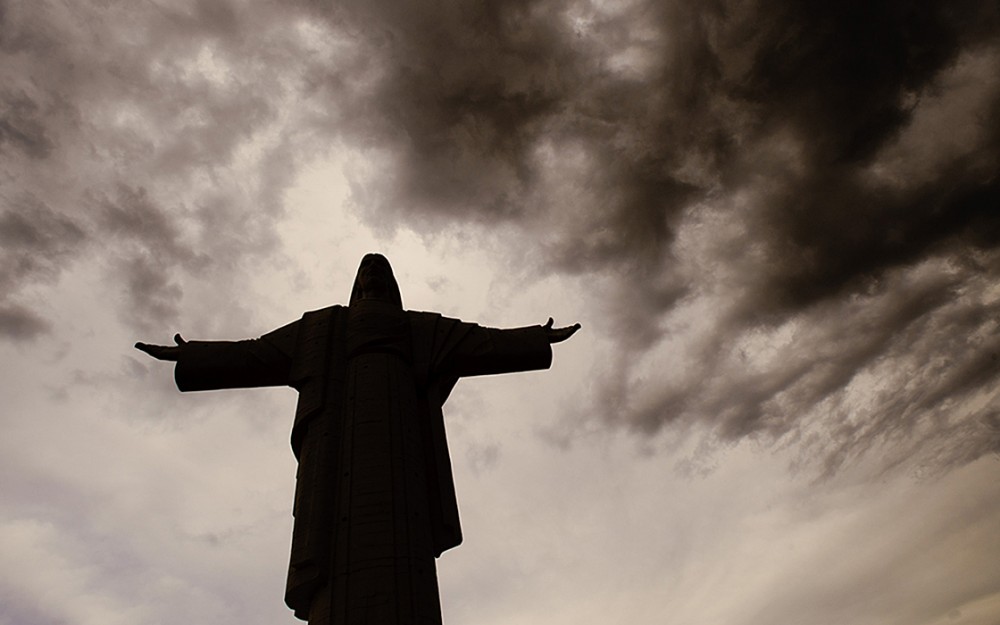
Cristo statue, Bolivia
Written and photographed by World Vision photographer Jon Warren
Nikon D3
17mm lens, 1/400th at f/8, 200 ISO
* * *
Towering atop a hill in the middle of Cochabamba, Bolivia, is one of the world’s tallest Christ statues — 132.7 feet high, outstretched arms pointing north and south. In the middle of assignments in nearby mountain communities where World Vision has projects, I finally had a few open hours in the afternoon and headed straight to the Cristo, such an important symbol of the region. The weather was awful and getting worse — wind whipping, dark clouds racing across the sky. Dwarfed by the enormous Jesus, I felt a little awkward photographing when I should be worshipping, but I decided to try some pictures anyway.
I pulled out my Nikon D3 and a 17-35mm/2.8 lens and set the ISO to 200. The first photos — purposely dark to emphasize tone in the clouds and keep the Cristo silhouetted — were dramatic, but I wasn’t sure what I was trying to say.
I moved to the steps below to try to get a better angle up against the sky. Ignoring the drops of rain, throngs of devotees and tourists crowded around the base. I waited for the crowd to fill every gap at the bottom of the frame. Some people looked up at Christ. Some didn’t seem to notice he was there. Then I saw the picture and understood the message: Jesus’ open arms welcomed the turbulent world below.
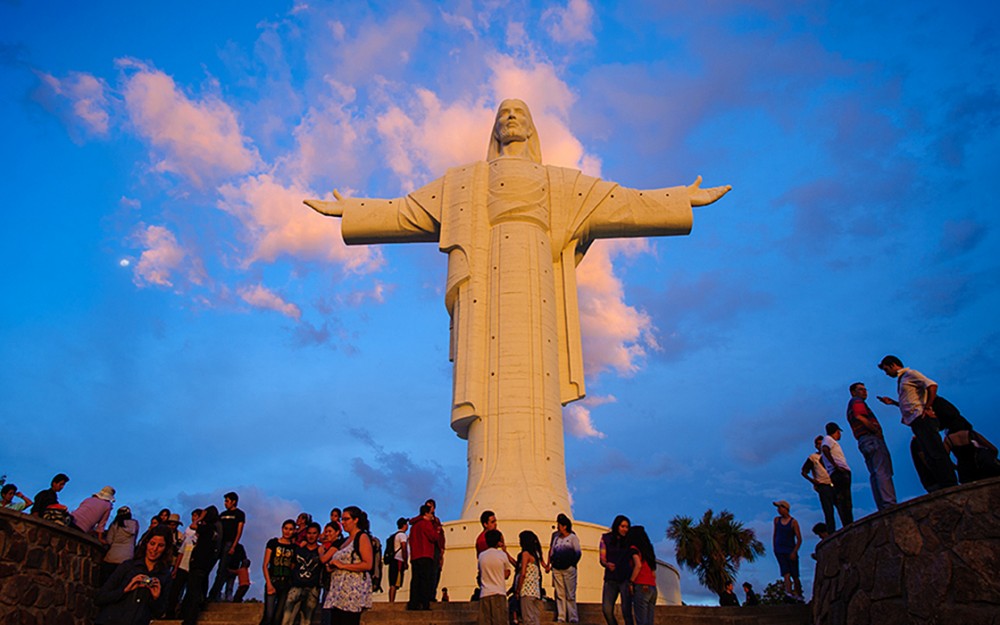
Photographs are made with light. And then there’s the story, the message — what you’re trying to say. The best images are a result of patience and, it often seems, divine intervention. I decided to wait until dark when I hoped floodlights would come on. Maybe that would provide more contrast between the statue and the gray sky.
And then something remarkable happened. Just before sunset, the clouds moved to the east and the sun broke through. Like the subjects in this frame and everyone else, I was transfixed by the sudden burst of light.
The last clouds turned pink and the Cristo golden. Again I waited for people to fill in the bottom of the frame, with the same message in mind as the earlier photo, but this time more hopeful.
Two images framed almost exactly the same, with the same intention, just hours apart. Radically different light and dramatically different impact. Both were unexpected gifts.
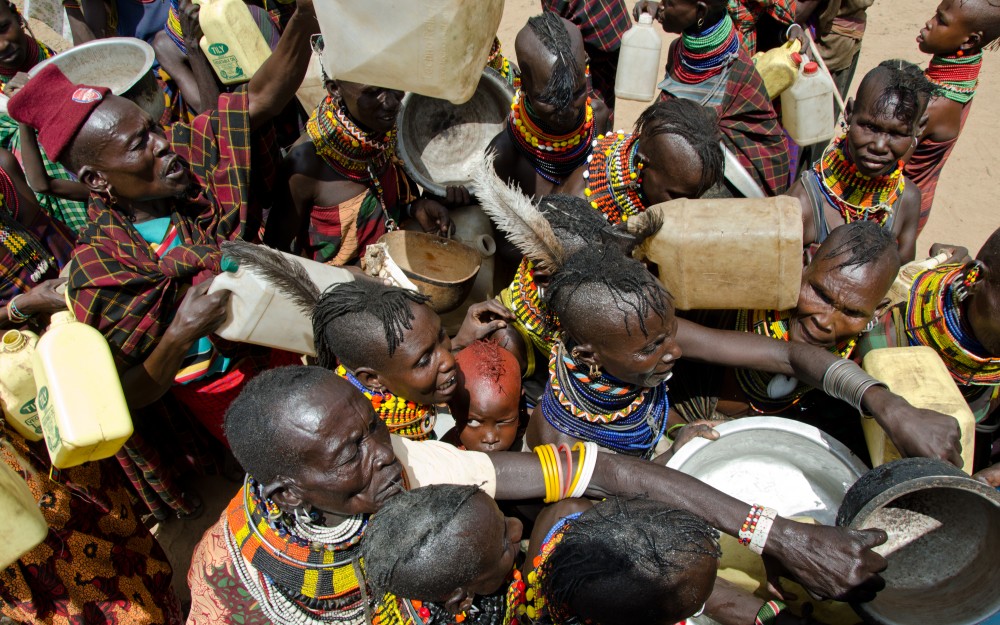
Water truck, Kenya
Written and photographed by World Vision photographer Abby Stalsbroten
Nikon D7000
18mm lens, 1/250th at f/8
* * *
I live in the Pacific Northwest region of the United States, a land characterized by copious amounts of both trees and rain. It couldn’t be more different from northwestern Kenya, an area called Turkana, which suffers nearly perpetual drought.
I visited Kenya in the spring of 2011 when the Horn of Africa was in the throes of the worst drought in more than 60 years. Crops were failing, water was scarce, and children were suffering most of all. Our team spent the majority of our time at malnutrition clinics, where tiny babies were fed therapeutic food that looks and tastes like peanut butter.
One day, we took a break from the clinics to see a different side of the drought. We drove for hours through hot, sandy terrain, occasionally passing herds of camels and goats. All the riverbeds we crossed had dried up. We saw just one person in three hours.
We finally reached our destination — a tiny village called Lopii. The moment I stepped out of the Land Cruiser, I could feel the heat through my thick-soled desert boots. I stepped into the shade of the village’s one tree to avoid burning my feet, though the villagers wore only thin leather sandals. Most of the children went barefoot.
In the shade of the meeting tree, we spoke with the whole village as they waited for one of the most important events that month — the arrival of the water truck. This truck comes every two weeks or so unless the truck breaks down. It is the size of a gas tanker and is full of sparkling clean water.
Their alternative to this? Walking eight miles one way to a questionable water source. Sometimes it takes so long that mothers make the journey, spend the night there, and then return home the next day. Meanwhile, their children have spent almost two full days without water — or their mother.
Men and women mobbed the water truck the moment it pulled up. Looking to remove myself from the chaos to get a better shot, I scrambled up on the back of the truck. Busy with their water containers, no one noticed me. From my perch, I noticed a little boy giving the side-eye to a woman in the midst of the jostling.
After a few minutes, the crowd calmed, and women — some pregnant — helped each other organize and carry the heavy containers home. They’ll carefully ration the water for the next week, and then have to make the long walk to the only other water source. Some mothers told me they had to forgo baths for their children, or even washing their dishes, because the water was too precious for anything but drinking.
I didn’t take any of my bottled water for granted for the rest of that trip. Or ever.
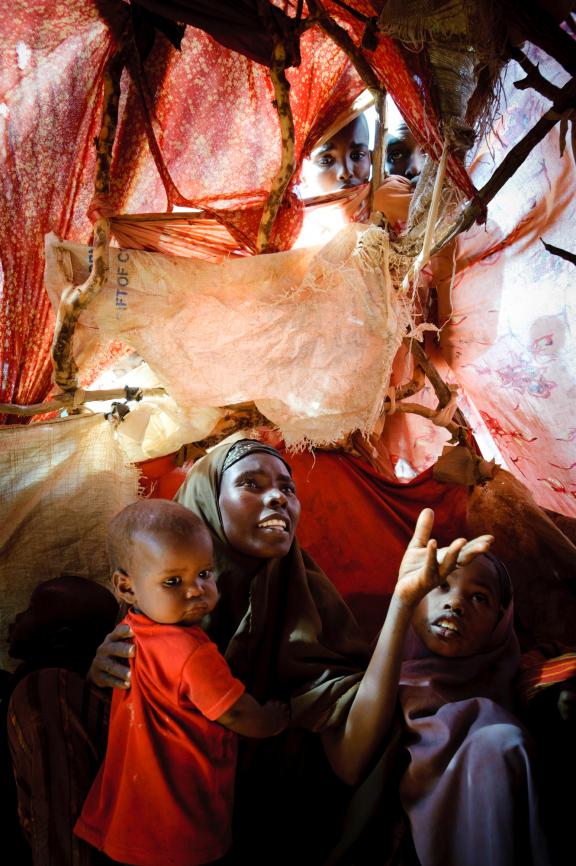
Beauty in ugliness, Somalia
Written and photographed by World Vision photographer Jon Warren
Nikon D3
30mm lens, 1/100th at f/6.3, 800 ISO
* * *
When a situation is full of ugliness, when the circumstances are awful, is there room for beauty in photographs? Does that dilute the advocacy message?
A prominent photo editor, whose advice I listen to closely, gently chided me after he saw a set of photos I had done of rape victims in Congo. There is no sense of the harshness of what happened to them, he told me. He felt the pictures were too “nice” for the awful subject matter.
My problem was that I heard the victims’ horror, but also saw beautiful people in front of me. I wanted to show both. And that’s what came through my camera. In wanting the reader to care about the person, I may have muddied the message.
Edward Curtis, a famous Seattle photographer a century ago, faced similar criticism. His life work was documenting the way Americans Indians had lived before the arrival of Europeans. Art critics accused him of showing only their glorious past, and not the squalor of their present-day on reservations. Still, to me, even his most elegant portraits reveal suffering and endurance, perhaps more poignantly because of their art than if he had been literal.
Not many reporters were able to get into Somalia during the famine in 2011. Most of the reporting was from Dadaab, a huge refugee camp in Kenya. But World Vision was also working inside Somalia and I was asked to help document that work. Staff drove me four hours south of Puntland Somalia’s primary city, Garowe. Families flooding out of south Somalia’s mayhem of violence and famine had begun to set up impromptu camps on the edges of towns in their desperate flight for survival.
Hadija Abdi, only 28 years old, had the burden of raising seven children during the famine. After the family’s crops failed she took her children and walked and hitched rides for eight days until she reached the town of Burtinle. When I met her she had been there for four days, just long enough to construct a tiny stick-domed hut covered in brightly colored cloth scraps. Hadija and eldest daughter Nurto, 10, earned a little by hauling garbage away for families in the nearby town or by begging.
I crammed into a corner of Adija’s hut and, as she told her story with passion and despair, I photographed with my Nikon D3 and a 17-35mm lens. A crowd had gathered outside and people peered through gaps in her cloth covering, so I included them in the frame, too.
I heard Adija’s anguish, but was also struck by the pattern of cloth and sticks, the soft light on the mother and children’s faces, the symmetry and balance.
The first time the photo was published in World Vision magazine, I submitted a black/white version, hoping this was hold reader’s attention on the mother and not distract from her condition. I wanted the family to receive help, not for viewers to be lost in the color and patterns.
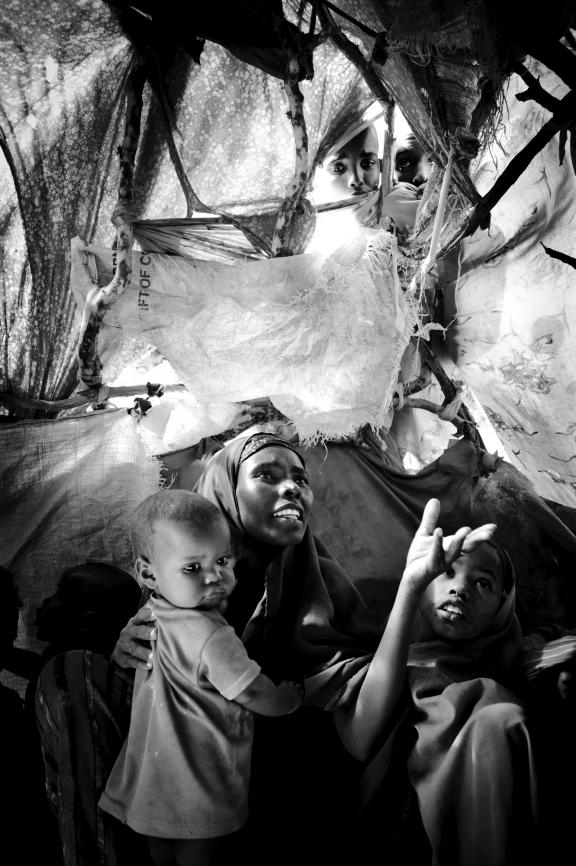
The photograph leaves me with two questions. The first is basic: Does the black/white version “save” the story?
The second is fundamental: Is there a place for beauty, for loveliness, when the topic itself is full of ugliness?
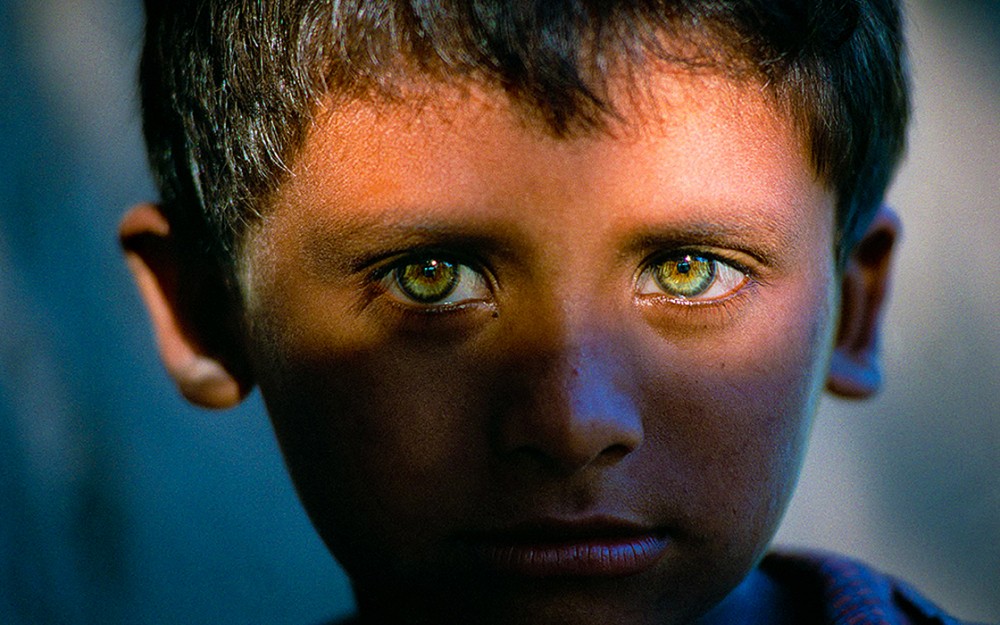
Geovani, Honduras
Written and photographed by World Vision photographer Jon Warren
Nikon F100
80-200mm lens, f/2.8, 200 ASA Kodak color print film
* * *
Sometimes it seems like a subject is looking right through the camera, directly communicating with the person seeing the picture as if there is no photographer in the middle at all.
I met Geovani a few days after Hurricane Mitch slammed into Honduras in 1998. To get to his village, La Barranca, I had to wade across a swollen river. I spent hours sitting with his family beside their collapsed home, listening to their stories. The river had swept through the community and flooded their house. Geovani was rescued by his brothers, along with his widowed mother and 15 other children. He had seen too much for a sweet 6-year-old.
Shafts of evening light filtered through the trees and onto his face. I put an 80-200/2.8 lens on the camera and set the exposure for the highlight area, a habit from years of using slide film. This time I was using color print film because World Vision needed to be able to scan images quickly and economically when I returned.
I had been asked to carry one of the early digital cameras, a Sony 640K model that could only produce thumbnail-sized pictures. But I had refused, worried I’d get only one chance at an image and the digital version would be too small for print. And it turned out I was right.
For just a brief moment, Geovani gave me that look, the one that goes through the photographer. I focused manually on his eyes (pre-autofocus days) and was able to click only one or two frames before he turned away.
Digital cameras have changed for the better, but what will never change is the reality that those special moments are fleeting.
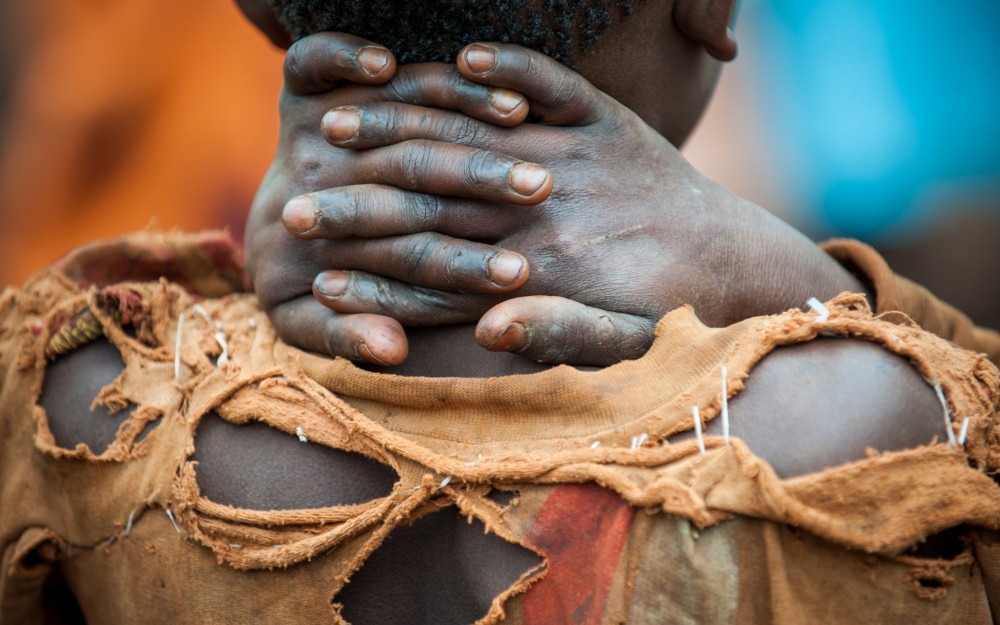
One word, Burundi
Written and photographed by World Vision photographer Jon Warren
Nikon D3
140mm lens, 1/160th at f/5, 400 ISO
* * *
Photographs may tell a thousand words, but I think they are much more effective when they shout just one.
This time the word I saw was “poverty” — stark, punch-you-in-the-gut destitution.
After decades of brutal conflict, in 2009 Burundi was stable enough for World Vision to begin a sponsorship program — meeting with parents and weighing, measuring, and photographing children.
Others had come to the big gathering in their nicest clothing. But this was all the boy had. He hovered on the edge, too shy to join in.
There was something so universal in the way he stood with his hands clasped behind his head, like a modern-day Huck Finn. Kids everywhere do that. And he wasn’t the only one with nothing decent to wear at the event.
I’ve helped write protocols for the way we photograph and publish images at World Vision. The beginning of the document — the premise the policy is based on — says, “We are advocates for the people we photograph. … They trust us to depict them truthfully and with respect.”
So where was the dignity in this boy’s situation? How could I be honest about what I saw, and yet respectful too?
I put a long lens on the camera so that I could stand at a distance, a 70-200mm, walked quietly behind him and concentrated just on his hands and tattered shirt. I clicked several frames quickly, not wanting to embarrass him or draw attention to him, and then carried on documenting the rest of the event.
Of all the photographs from Burundi that week, this is the one that has had the widest usage and biggest impact on an American audience. It ran as a two-page opener for a related story in the World Vision magazine. The message is unambiguously direct: this is what dire poverty looks like.
In these situations, it’s my responsibility to record injustice, not gloss over it. It isn’t right that this boy has only rags to wear. But I need to constantly remind myself in doing this to be a compassionate advocate.
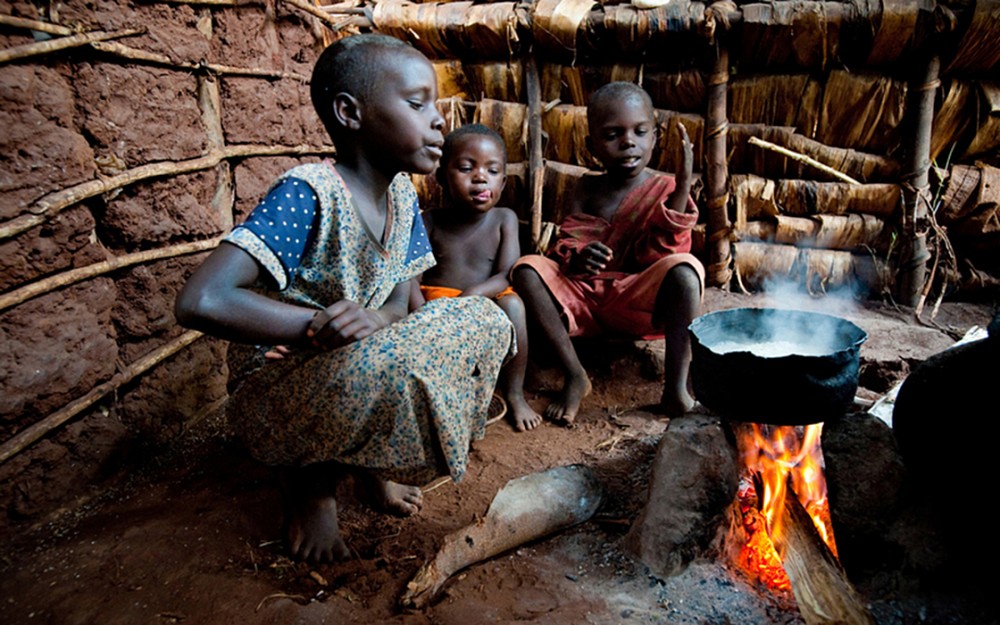
Boiling beans, Burundi
Written and photographed by World Vision photographer Jon Warren
Nikon D700
26mm lens, 1/25th at f/4.5, 1600 ISO
* * *
Three children cooking their only meal of the day — a glimpse into what poverty really looks like in this village in Burundi.
A friend at work asked me what the formula is for coming back with meaningful photographs from difficult situations like this. My answer: relationships, access, and hard work.
Step 1: Relationship. Begin with World Vision staff who have gained the trust of the community through years of responding to their needs. They, in turn, introduced us to the single mother of these children. With our translator, we sat with the family by their banana-leaf hut, hearing about their lives. It was the first step in beginning to care for each other, developing a relationship.
Over the course of the next few days, World Vision writer Kari Costanza and I spent many hours with the family — going with them to fetch water, watching as they weeded their small potato patch, and chatting as they prepared their one meal of the day. Through this growing relationship, they gave me access to photograph their lives.
So by the time the children sat by the fire hoping the beans and potatoes would cook faster, they were completely undisturbed by my camera.
Step 2: Access. Life happened, and I recorded it. I used my Nikon D700 because the light was dim and that camera has a wonderful low-light sensor. I usually carry two cameras on assignments — in this case, a Nikon D3 and a D700. And my normal lenses are a 17-35mm/2.8 wide zoom, perfect for cramped spots like this, and a long lens, usually a 70-200mm/2.8. One lens goes on each body. Even at 1600 ISO, I had to use a slow shutter speed — 1/25th, but I wasn’t too worried because the kids were mostly stationary. Except when Pascal (middle) stuck his tongue out. That, and Collette’s intense study of the cooking pot, were the moments I was looking for.
We spent one last day with the family — Sunday. They washed clothes on Saturday, their one good outfit, and early Sunday we walked with them to church. Worship for these folks isn’t a social habit. They come because they depend on God, openly and without abandon.
Step 3: Hard work, but I’m not sure that the privilege of sharing a few days with saints like these qualifies as work.
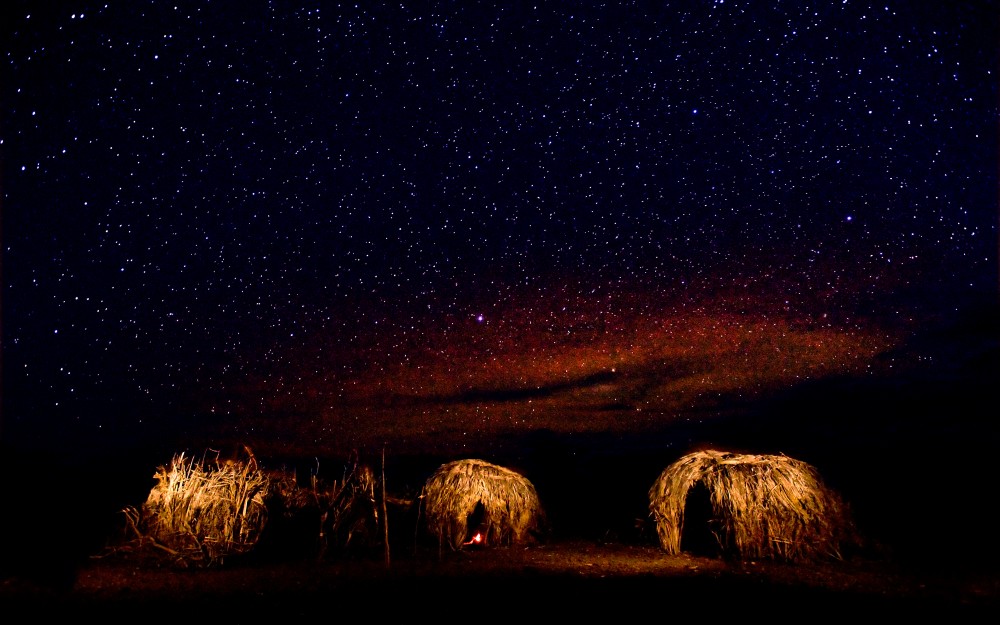
Turkana night sky, Kenya
Written and photographed by World Vision photographer Jon Warren
Nikon D3
17mm lens, 30-second exposure at f/4, 3200 ISO
* * *
In 2008, World Vision writer Kari Costanza and I spent five days living with a grandmother named Ekomol and her family in Turkana, northern Kenya, to try to understand and document what it’s like to survive only on rations from food distribution.
At night, before going to sleep, the family sat outside around a small fire and sang gentle hymns. It should have been pitch black, because the moon was still below the horizon. But the stars were brilliant all the way down to the horizon, sharp and intense and barely out of reach.
I had a new Nikon D3 and wasn’t sure of its capabilities. I pulled out the camera with a 17-35mm lens, set it on aperture priority, cranked up the ISO to 3200 (which seemed insanely high back then), and casually clicked a frame pointed at the sky — a long, long exposure before the shutter finally closed. But then I looked at the LCD on the back of the camera. Unbelievable! Although blurry from my shaking, I could clearly see the stars.
I grabbed my tripod, stumbling over the lava rocks and thorny bushes. I lined up the camera, focused carefully, kept the ISO at 3200, aperture at f/4 to try to get a little depth of field, and dialed in a manual exposure of 30 seconds — the longest setting I could do without going to “bulb” and just fast enough to avoid star movement.
To include the light from the fire inside the hut, I had to photograph with my back to the dense Milky Way, but still, the stars looked amazing. Click — then a long wait before the exposure ended and an image came up on my screen. The stars looked great, but the huts were only barely visible silhouettes. All I could see was the small flame from the fire. I needed to do something to light up the huts more, but direct flash seemed too harsh and unnatural.
I borrowed a hand-held flashlight from Kari to try something I’d only read about: light painting. For the next hour, I clicked the shutter open and then raced all over the scene “painting” the huts with light for 30 seconds, waving the flashlight back and forth and counting my time — five seconds on this side, another five there — making sure never to put my body between the light and camera or to point the flashlight at the camera. The family thought I was insane, even when I showed them the camera screen. So did Kari.
The wonderful thing about digital cameras is that you can see what your results are right away. I’d have everything right in one part of the photo, but the lighting would be totally uneven in another. So I kept trying until I got it right — and then did it again the next night. That was all the family and I could take.
I’ve done photography for 30 years, but I feel like I learn something new every day!
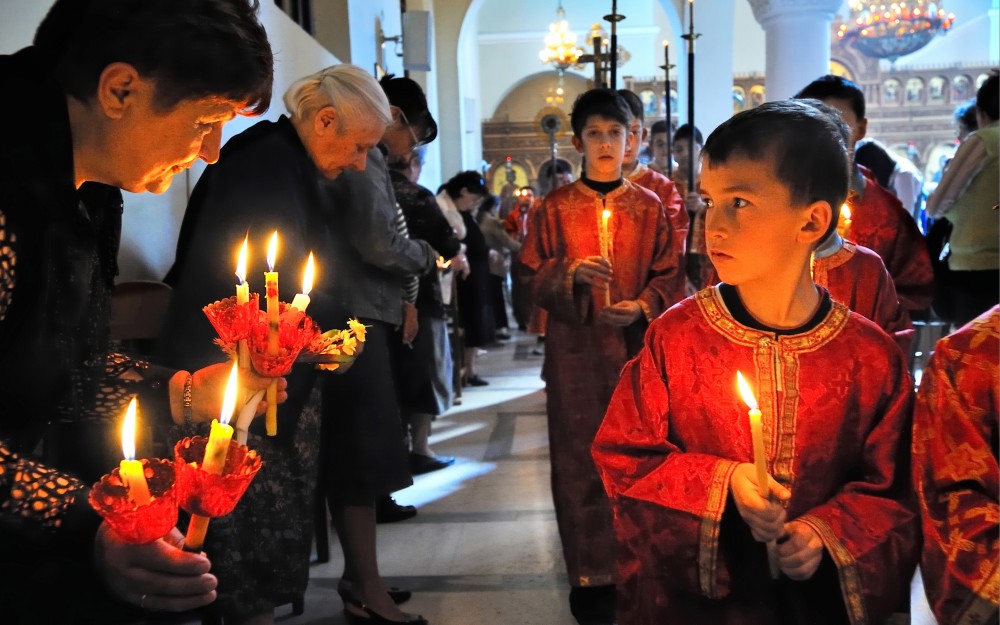
Orthodox service, Albania
Written and photographed by World Vision photographer Jon Warren
Nikon D3
28mm lens, 1/100th at f/5.6, 2500 ISO
* * *
In 1945, the communist revolution in Albania marked the beginning of extreme persecution of all religious groups in the country. In the next decades, the government killed almost all the Orthodox priests and ministers and converted churches to hay barns and warehouses.
Andrea Laksa’s parents were raised as atheists from birth, with no concept at all of God. But when 8-year-old Andrea (that’s a boy’s name in Albania) began to attend Christian education classes through World Vision at the Annunciation Church in Tirana, his parents came to see what he was learning.
Photographing in churches makes me uncomfortable. They are a sacred space, and I’m concerned about distracting people who are worshipping. But my assignment was to tell this story, and I hoped for one photograph that said it all.
This Sunday, Andrea was scheduled to be an altar boy. It was a responsibility he took seriously. I knew the candles and colorful vestments offered an opportunity for a unique photograph. I could always pose Andrea with his parents, but much more preferable was to record a real-life moment during the service. During the week, I made certain I had permission to photograph on Sunday and learned where I was allowed to go in the sanctuary. I promised to be discrete and respectful. And then on Sunday, I came to the church well before the service began to look at the lighting and find a good place to stand.
It was dim, but flash was completely out of the question, so I set my ISO quite high — 2500. Mostly I planned to use a wide-angle lens, 28 mm. I wanted to be close to the subject and still capture the magnificent interior. My telephoto was handy, in case I needed it, too.
When Andrea and the other altar boys entered the sanctuary, they stood still for several minutes. I took a few photos of Andrea with the others, to confirm my exposures, but I needed adult worshipers in the frame to tell the story. I looked down the route the children would parade toward the altar. There was a woman holding candles. I quietly moved next to her, to be ready when Andrea and the others marched past. I set focus and framed the photo. When Andrea came into the picture, I began to click the shutter. The “story moment” came when he turned to look at the woman and she bowed to him.
Besides the stunning pageantry of the service, where each gesture and symbol had deep meaning, I mostly remember the glorious singing: rich minor-key harmony echoing off the domed ceiling, taking me into the presence of God. The archbishop was presiding that day in all his splendor. But it was the simple faith of the children that filled the church to overflowing.
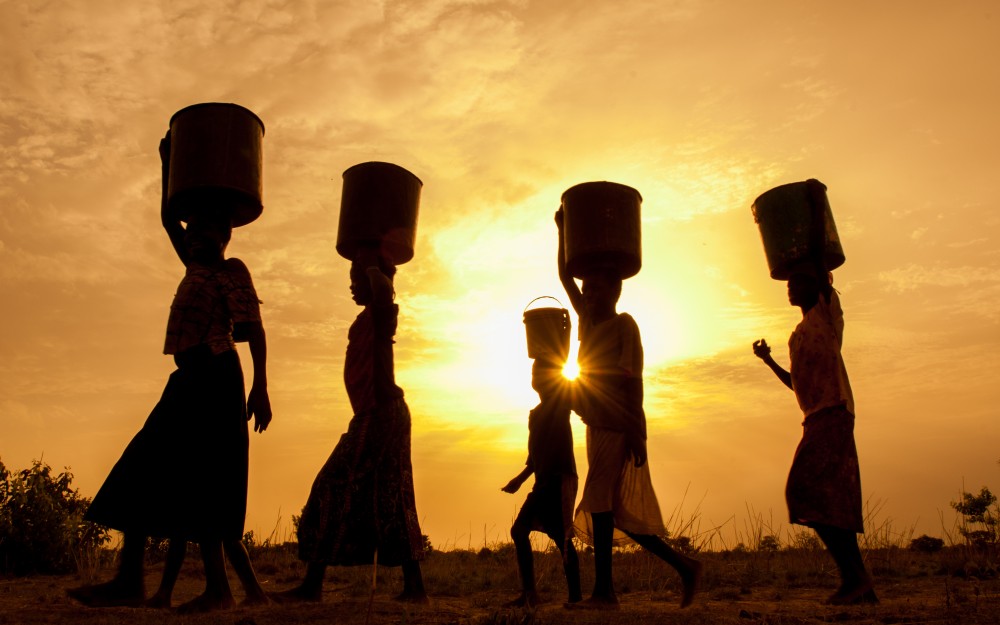
Water sunrise, Ghana
Written and photographed by World Vision photographer Jon Warren
Nikon D2X
17mm lens, 1/125th at f/14, 100 ISO
* * *
Still photographs freeze one brief moment in time — in this case, 1/125th of a second. I want to make sure that instant is worth sharing, which can sometimes mean a lot of hard work.
World Vision videographer Tom Costanza and I were in Ghana to cover water projects. We wanted to document how difficult life is for people who live without access to clean drinking water. A community told us they collected water from a distant, stagnant pond at dawn every day. We made sure we were there before sunrise the next morning.
I started by photographing villagers, mostly girls, as they scooped filthy green muck into their buckets. Turning to watch a group of six as they climbed up the pond embankment with heavy, dripping buckets on their heads, I had an idea for a more dramatic photograph: a silhouette.
I raced down the path ahead of them. I quickly chose a small aperture, f/14, metered off the sky, and set my white balance as warm as possible, 10,000K, to keep the sunrise colors. I widened the 17-35mm zoom all the way to 17mm and manually focused to about 8 feet.
As the group approached, I set the camera on the ground, and, aiming blindly, clicked as they walked past. I reviewed the pictures on the back of the camera. The idea was good, but several of the girls blended together.
So I raced ahead again and went through the same routine. This time the water carriers looked great, but there was a tree in the background that was distracting. The girls carrying the water had such heavy loads that they barely seemed to notice me. Plus, we’d already met at the water hole, and they knew why I was taking pictures.
I dashed ahead again, put the camera on the ground, and tried once more. Everything was much better, but now I noticed the sun in the frame for the first time and knew it could add even more to the scene if it was in just the right spot. So once more, I sprinted ahead and waited for the girls to walk by.
I did this over and over again. Each time something in the picture wasn’t quite right. The girls walked fast, and I was tired! But finally, after about a mile of chasing them, the picture came together. It was worth it.
Although the scene looked idyllic, the buckets they carried weighed over 40 pounds and were filled with disgustingly putrid water. The best way I could help the community was to share their photo and story with tenderhearted and generous people who have the means to bring clean drinking water to this village.
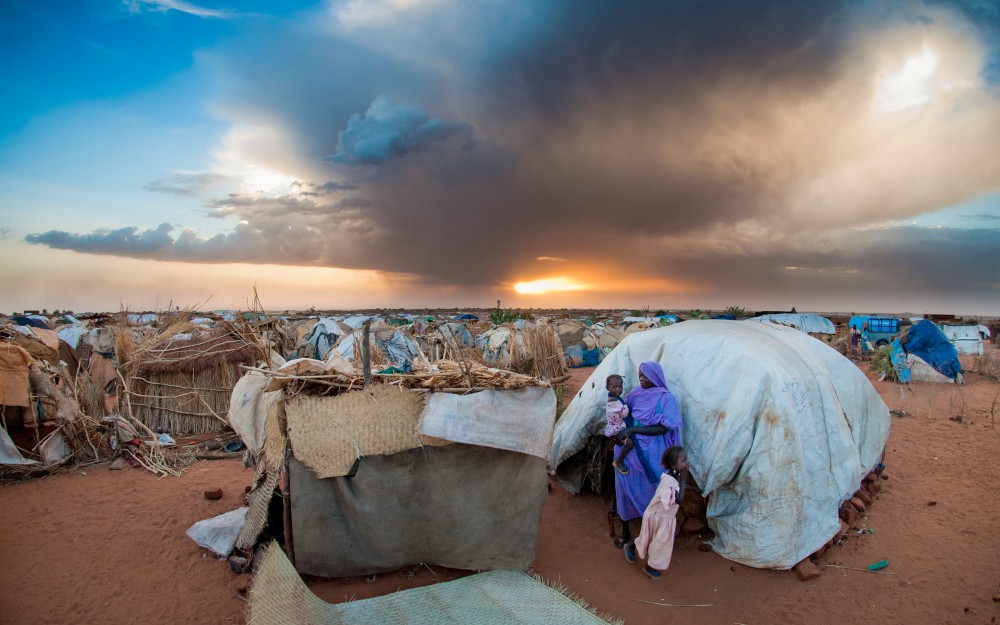
Gathering storm, Darfur
Written and photographed by World Vision photographer Jon Warren
Nikon D200
10.5mm lens, 1/250th at f/5.6, 250 ISO
* * *
In 2006, 2 million internally displaced people filled the horrific camps in Darfur — a mind-numbing statistic. Writer Dan Teng’o and I concentrated on telling one family’s tragic story.
Widow Haja Osman and her children lived amid mayhem, death, rape, and terror — all too awful to even contemplate. Besides intimate glimpses of their daily life, I knew I needed a scene-setting image that gave a sense of what the camps felt like. But Darfur is totally flat, and there were no water towers or high structures to climb up, and the camp was a chaotic jumble.
On the second day, we stayed until close to dark. I could see a storm approaching. The family stood outside their tarp home, with the dramatic clouds and setting sun forming a dramatic backdrop. I stepped up on the only thing I could find that gave me a little elevation — some rocks bordering the road. I used a 10.5mm fisheye lens to capture the widest view possible, keeping the horizon in the middle so the lens wouldn’t curve the scene too much, and metered off the sky, hoping I still had enough detail in the family’s faces.
The storm came quickly, filling the air with sand. The family rushed into their shelter, and we went back to the relative safety of the World Vision staff house. I say “relative” because staff have been killed and injured serving the people of Darfur. It remains an incredibly difficult place to work, and the political situation that caused so many to flee is still unresolved.
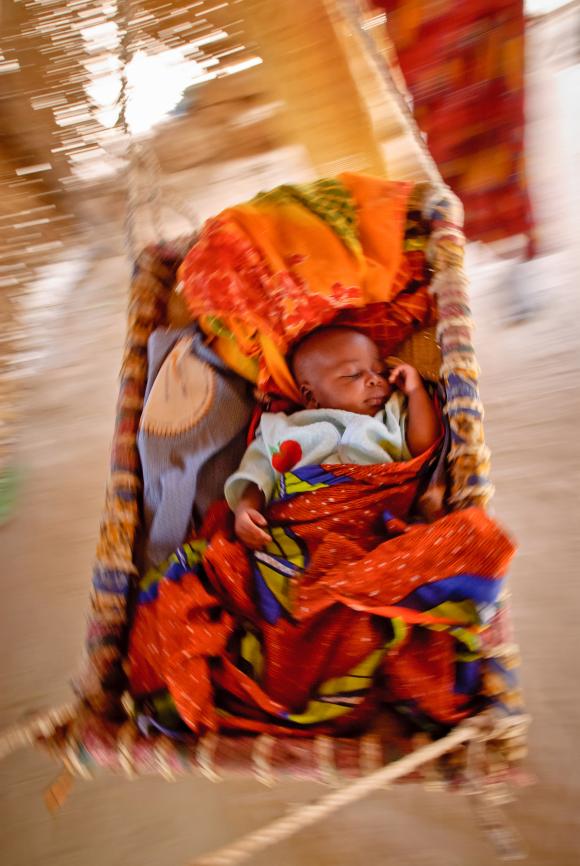
Rocking baby, Niger
Written and photographed by World Vision photographer Jon Warren
Nikon D200
17mm lens, 1/20th at f/8, 400 ISO
* * *
When people learn that I do photography for World Vision, a humanitarian agency, one of the most frequent questions I hear is, “How can you face all that suffering all the time?”
The first time I was asked this I was taken back a bit. Of course, I’m confronted with awful circumstances some of the time and see some terrible things. But more often than not, there is beauty and uniqueness in the people I meet, and I’m struck by the sense of common humanity under God. That’s what I’m trying to say with my photography.
In the middle of hot day in Dara village in Niger, I wandered into the shade of a woven roof to get out of the sun. A sleeping baby, Abida, was in a cradle suspended from the roof joists by long ropes. Each time someone walked past, they gave the cradle a shove. Abida was blissfully content in the middle of brightly colored cloth, swinging back and forth.
I raised my camera to take a picture and her mother, trying to be helpful, stopped the baby’s rocking. I chose the widest setting on my 17-35mm lens because the cradle was set quite high and I wanted to include some of the setting. The picture was OK but rather boring.
When the baby started to stir, the mom gave the cradle a good push. I love motion pictures where the main subject is sharp while the rest of the scene has interesting blurs — but it’s always hit-and-miss to make it work. I started by setting a really slow shutter speed, probably a quarter of a second, and then swayed in rhythm with the cradle, trying to keep my camera moving at exactly the speed of the baby’s face.
I love digital because I can see right away if what I’m doing is working. A quarter of a second was too slow — I couldn’t get anything sharp. I kept experimenting until I settled on 1/20th. And then I clicked and clicked and clicked. The baby wasn’t going anywhere, and it was too hot to go back out into the sun. Finally, there was one picture where Abida’s sweet face was nice and sharp and the rest of the frame brushstrokes of color and light.
Abida’s family lived on about $1.25 a day, and her life on the edge of the Sahara desert would be challenging. But with each gentle push on the cradle, the love and support of her community was confirmed.
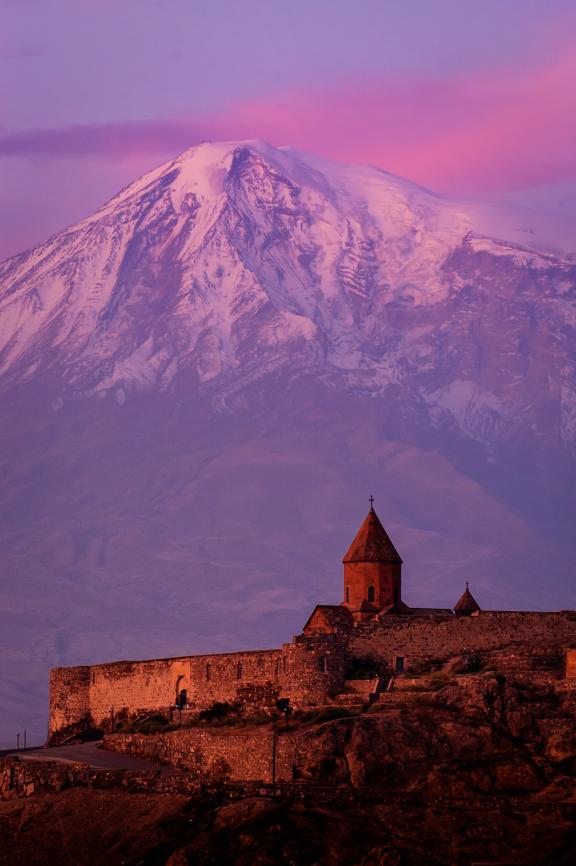
Mt. Ararat, Armenia
Written and photographed by World Vision photographer Jon Warren
Nikon D200
150mm lens, 1/30th at f/5.6, 400 ISO
* * *
I love mountains. I was born in the Himalayas and live within sight of Mt. Rainier. Any chance I get, I’m off hiking.
World Vision writer Kari Costanza and I were in Armenia in 2003 to do stories on World Vision’s child sponsorship work. Mt. Ararat — the Ararat from the Bible, all 16,854 glorious snow-covered feet of it — loomed over the capital, Yerevan. The staff loved that mountain and constantly pointed it out to us as if I wasn’t already gawking at it all the time. Finally, I couldn’t take it anymore. There had to be a way to justify photographing it up close.
Kari assured me that we needed general photos of the country along with specific coverage of the programs for the kids. That’s all the encouragement I needed. The Armenian staff were thrilled to take us there, too, until I told them I really needed to start photographing before sunrise. I’d been watching the mountain all week. It faced east and at sunset was mostly backlit. I wanted that early morning glow instead.
Ararat is on the Turkish border, and it was about a three-hour drive from Yerevan, if I remember correctly. I made Kari and a poor staff member leave Yerevan before 3 a.m. But then, as we all stood shivering around my tripod before dawn, the first bit of color spread down from the summit until the glaciers were all pink.
The staff member told us that the Khor Virap monastery in the foreground was built above a prison where Saint Gregory, the first missionary to Armenia, was imprisoned for 13 years until the king converted to Christianity in 301 A.D., making Armenia the first official Christian nation.
I tried a variety of lenses as the light got more and more beautiful, but not with much confidence. This was my first overseas assignment using a digital camera — the brand-new Nikon D100. If I’d been using slide film, I would have chosen Velvia, with its dynamic colors and deep, rich blacks. It would have been perfect for this scene. But digital was a whole new craft, and I wasn’t quite sure what to expect, or even how to expose the scene properly. I think I metered manually but went with auto white balance because everything looked OK on the camera’s LCD screen.
A horizontal version of this picture ran as a two-page opening spread when the story was published in World Vision magazine. I still find myself staring every time I look at the picture. But now that I know the whole story, I’m just as transfixed by the monastery in the foreground where a faithful man endured patiently for 13 years, believing God had a purpose in his suffering.
Read more testimonies from World Vision photographers in our Life Frames series.
